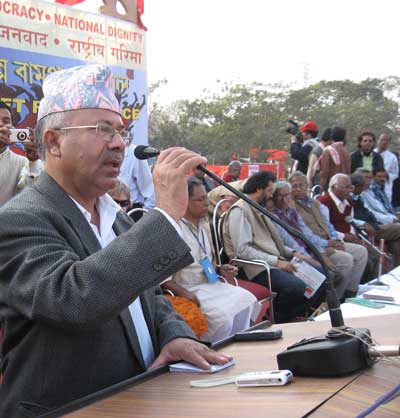 Nepal today has been passing through a historic transition period. The popular uprising of April 2006 has forced the autocratic monarch to surrender power to the political parties and restore the dissolved parliament. The defeat of the monarchical rule and the formation of the political parties’ government have paved the way for a dialogue process and comprehensive peace agreement with the Communist Party of Nepal (Maoist) who have been waging armed struggle for the last decade. To consolidate and institutionalize the people’s movement, the newly formed all party government tabled a historic proclamation in the restored House of Representatives in May 206 and passed unanimously. The HoR declared itself as the sovereign body of the nation, all the executive powers are now to be vested in the Cabinet, substituting ‘His Majesty’s Government’ with ‘Nepal Government’ and declaring the country to be a secular state. The nine-point declaration of the HoR also curtailed the King’s powers. Through this declaration the Nepali people have become true masters of their nation and have ended the 237-year-old rule of the Shah dynasty.
Nepal today has been passing through a historic transition period. The popular uprising of April 2006 has forced the autocratic monarch to surrender power to the political parties and restore the dissolved parliament. The defeat of the monarchical rule and the formation of the political parties’ government have paved the way for a dialogue process and comprehensive peace agreement with the Communist Party of Nepal (Maoist) who have been waging armed struggle for the last decade. To consolidate and institutionalize the people’s movement, the newly formed all party government tabled a historic proclamation in the restored House of Representatives in May 206 and passed unanimously. The HoR declared itself as the sovereign body of the nation, all the executive powers are now to be vested in the Cabinet, substituting ‘His Majesty’s Government’ with ‘Nepal Government’ and declaring the country to be a secular state. The nine-point declaration of the HoR also curtailed the King’s powers. Through this declaration the Nepali people have become true masters of their nation and have ended the 237-year-old rule of the Shah dynasty.The ultimate goal and mandate of the whole people’s movement and the peace process were to hold elections to the new Constituent Assembly to draft a new constitution, federalize the present central form of governance system, initiate massive social and economic reform programmes and make the state and system of governance more democratic and inclusive by providing fair representation to the marginalized and oppressed classes and indigenous groups in the state machinery and other decision-making bodies.
At the moment, there is a serious political deadlock in the country. A new election date is yet to be announced. Despite a series of bilateral and multilateral dialogue and negotiations, the political parties have not been able to come out with a solution to break the deadlock. As a result, the country is in utter political confusion. The people seem to be disappointed. Though the monarchy has been completely sidelined and the King is totally powerless, political change is yet to be institutionalized. The Maoists are still threatening to prevent elections if their demands are not met. The government and political parties are gradually losing their credibility gained through the historic people’s movement.
The Maoists are demanding immediate declaration of the republic in the existing interim parliament and introduction of total proportional election system in the country. However, the Nepali Congress, one of the major coalition partners, is not prepared to accept these demands. It has been arguing that both these issues should be addressed as per the interim constitution in which it has been mentioned that the first meeting of the constituent assembly will decide the fate of the monarchy by simple majority and mixed election method will be adopted in the election. Dialogues and negotiations are on but a solution is yet to be found. This situation has seriously threatened the unity of the political parties. However all political parties are for the unity to institutionalize the historic political change, to restore lasting peace and take the country towards progressive transformation.
The left parties are in a majority in the current interim parliament. The recently held special session of parliament passed a resolution to address the issue of declaring a republic and proportional election system with an understanding among the left parties together with the CPN (UML) and the CPN (Maoist). At this juncture we have been urging the government to implement those parliament resolutions and declare the date of election for the constituent assembly by reaching an understanding among the seven parties.
Being one of the strongest members of the SPA and its wider support base strong national and international organizational network, the CPN (UML) has played a decisive role in the people’s movement of April 2006. It played a catalyst role in bringing the seven mainstream political parties onto one platform and formulating a six-point understanding among them. It also took an active and leading role in developing the 12-point understanding with the CPN(M), holding several rounds of bilateral and multilateral talks with them to persuade them to agree for an understanding with the SPA.
The CPN(UML) was the first party to organize massive rallies and protest programmes against the royal regime at a nationwide level after the February 1 royal coup. It also took an active part in all the programmes organised jointly by the seven parties all over the country. During the second pro-democracy movement, 21 people were brutally killed by the royal regime, of whom 16 were active members of the CPN(UML). Among the 6000 injured, more than half of them were members and supporters of the CPN(UML). Tens of thousands of members of this party were arrested and detained for long periods of time during the last fifteen months.